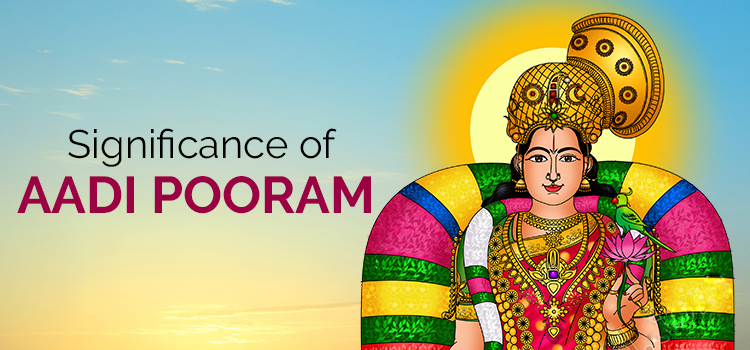Aadi (July-August), the 4th month in the Tamil calendar, is an important month for Tamils. It is a month in which festivals come tripping hot on the heels of one another. There is Aadi Pirappu, Aadi Pooram, Aadi Krithigai, Aadi Velli, Aadi Perukku, Aadi Sevvai, and so on.
Significance of Aadi Pooram
Aadi is a month for spiritual activities as it marks the beginning of Dakshinayana Kalam when the Sun moves southwards. This is the nighttime of the gods.
The month holds great significance for the farming community as well. Their livelihoods depend on the monsoon rains, which can make or break them. As with anything else, it shouldn’t be too little or too much. Little wonder, then, that this month is significant for the worship of Mother Nature in the form of Goddess Shakti and her various forms, who, as water goddesses, decide the fate of those who live in villages and depend on agriculture.
The significance of Aadi Pooram is two-fold. Aadi Pooram is the day of the month when Pooram star rules. This day has significance for both Vishnu and Shiva devotees. On the one hand, it is the birthday of Goddess Andal, Vishnu’s consort. So it is also known as Andal Jayanti. On the other hand, Goddess Parvati’s Valaikappu, or bangle ceremony, is also on this very day.

Andal’s Story
Andal is an avatar of Goddess Lakshmi. She is the only female among the 12 Vaishnavite poet-saints called Alwars.
Vishnucittar (Periyalwar) found Andal lying under a Tulsi plant in his garden. Periyalwar used to do odd jobs in the Vadapatrasayi temple in Srivilliputhur in southern Tamil Nadu. He was a great Vishnu devotee and made garlands daily for Rangamannar, the presiding deity of the temple.
The day he found the baby girl coincided with Pooram or Purva Phalguni Nakshatra/star; hence devotees observe it as Andal Jayanti. He had no children, so he raised the girl and gave her the name, Kothai. The child grew up on the tales of Krishna that her father narrated to her. Slowly, her devotion transformed into love, and Kothai imagined that she was Vishnu’s consort.
She took to wearing the garland made by Periyalwar to see how it looked on her. She did it without her father’s knowledge, as it was blasphemy to use something that was for God’s use. But, one day, Periyalwar saw a strand of her hair in the garland. He caught Kothai in the act of wearing the garland and was very upset with her. He scolded her for defiling the garland and feared that he would have to suffer divine wrath for Kothai’s insolence.
That night, he had a dream. Vishnu came in his dreams and told him that he would wear only the garlands that Kothai had worn. Her devotion made the garlands all the more fragrant, he claimed. Periyalwar realized that Kothai was no ordinary girl, she was the goddess herself. Thus, she got the name Andal or one who ruled the lord. Kothai continued to wear the garlands meant for Vishnu. When she attained maturity, her father began to look for a good groom for her. But Kothai wanted to marry Krishna. Vishnu, in his Ranganathar form in Srirangam temple, appeared to Periyalwar in a dream and told him that he wished to marry Andal and asked him to bring her to the temple, decked as a bride. At the temple, Kothai merged with Vishnu in the sanctum.
This supposedly happened on the day of Panguni Uthiram. Andal has sung many hymns on the presiding deities of many Vishnu temples. They are called Nachiyar Thirumozhi. Andal also observed a vrat, Paavai Nonbu, in the month of Margazhi (Dec-January) to marry Ranganathar. The 30 Tamil hymns which she sang on the 30 days of the month form the Thirupaavai. Unmarried girls observe the vrat even now to get a good husband. A 10-day festival takes place in Srivilliputhur in Aadi month, which culminates in a glorious chariot festival on Aadi Pooram.
Aadi Pooram is a 10-day festival that is celebrated with great fanfare in all Vishnu temples in Tamil Nadu. The 10th day is ‘Aadi Pooram,’ and the highlight of this day is Thirukalyanam or the grand marriage ceremony of Goddess Andal and Sri Ranganathaswamy.
Shaivite Festivities
Shaivite Tamils perform the Valaikappu/ Seemantham ceremony of Goddess Parvati on Aadi Pooram. It is also believed to be Parvati’s birthday. Women offer glass bangles, turmeric, Kumkum, etc., to the goddess. In Amman temples, garlands of colorful bangles adorn the goddess.
After some days, the bangles are given as prasad to women. Supposedly, they offer protection to the husbands of married women. In the case of unmarried young girls, they will be able to find a good husband. Women without children will be blessed with progeny. It is a matter of great pride and joy for women to be a part of the goddess’ Seemantham ceremony.
Rituals of Aadi Pooram
Women rise early on this day and start the preparations. They clean the house and draw kolams. Goddess Andal loves lotus flowers, red color, and kalkandu rice. The women make an elaborate meal to offer the goddess.
In the temples, priests adorn Andal’s idol with silk saree, ornaments, and garlands. The goddess is offered an elaborate feast, with every household in the community contributing to it.
There are special rituals, and traditional music is played. The celebrations go on till late at night, and after performing Aarti, food is distributed among the devotees. Devotees read the ‘Thiruppavai’ and ‘Lalitha Sahasranamam’ on this occasion.
The celebrations are more grandiose in the Goddess Andal temple at Srivalliputtur, which is the birth place of Andal. It is a 12-day festival. The Srirangam Sri Ranganatha Temple also celebrates the festival for 10 days. On the last day, the Thirukalyanam, or marriage ceremony of Ranganatha and Andal, takes place. Unmarried girls who worship Andal on the last day will supposedly get married soon. If the festival falls on a Friday, it is even more auspicious, and the celebrations will be more elaborate.
The Aadi Pooram car festival attracts thousands of devotees from across Tamil Nadu. The presiding deities are brought in a golden chariot within the Srivilliputhur temple premises

